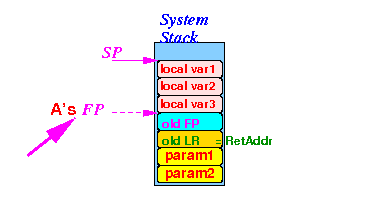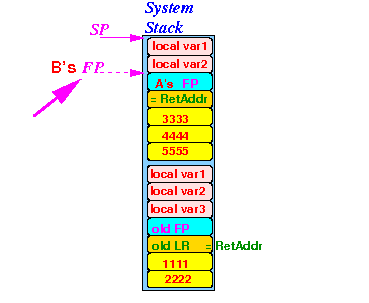public class Sample
{
public static void main( )
{
A(1111,2222);
}
public static int A( int a, int b )
{
int x, y, z; // Define 3 local vars
// I want to show you where to
// find the parameters and
// local variables on the stack
return(9999); // A( ) simply returns 9999
}
}
|
This examples shows you the steps to build + tear down stack frame for 1 (non-leaf) subroutine
main:
mov r0, #2222 // Pass 2222 as parameter 2 on stack
push {r0}
mov r0, #1111 // Pass 1111 as parameter 1 on stack
push {r0}
bl A // Call function A
add sp, sp, #8 // Clean up parameters on the stack
// When A returns, you will see the return value in r0 = 9999
nop
nop
Stop:
nop
/* ==============================================
Function A: param and locals in stack
============================================== */
A:
// When run in EGTAPI - you will see {1111, 2222} on stack
/* ****************************************
Prelude: build stack frame
**************************************** */
push {lr} // Save return address in LR
push {fp} // Save Frame Pointer in FP
mov fp, sp // Initialize my own FP
sub sp, sp, #12 // I create 3 local variable in stack
// How to to access parameters and local variables
// stored in the program stack
ldr r0, [fp, #8] // Get parameter 1 = 1111
str r0, [fp, #-12] // Store in local variable 1
ldr r1, [fp, #12] // Get parameter 2 = 2222
str r1, [fp, #-8] // Store in local variable 2
add r0, r0, r1
str r0, [fp, #-4] // Store sum in local variable 3
/* ====================================================
We can use a register to return the return value
==================================================== */
mov r0, #9999 // Pass return value in register r0
/* ************************************************
Postlude: break down stack frame
************************************************ */
mov sp, fp // De-allocate the local variables
pop {fp} // Restore old FP
pop {pc} // Return
|
DEMO: /home/cs255001/demo/asm/8-sub/skel-access.s
|
public class Sample
{
public static void main( ) {
A(1111,2222);
}
public static int A( int a, int b ) {
int x, y, z; // Define 3 local vars
B(3333,4444,5555);
return(9999); // A( ) simply returns 9999
}
public static int B( int a, int b, int c ) {
int x, y; // Define 2 local vars
return(8888);
}
}
|
This examples shows you the steps to build + tear down stack frame for 2 (non-leaf) subroutines
main:
mov r0, #2222 // Pass 2222 as parameter 2 on stack
push {r0}
mov r0, #1111 // Pass 1111 as parameter 1 on stack
push {r0}
bl A // Call function A
add sp, sp, #8 // Clean up parameters on the stack
// When A returns, you will see the return value in r0 = 9999
nop
nop
Stop:
nop
/* ==============================================
Function A: param and locals in stack
============================================== */
A:
// When run in EGTAPI - you will see {1111, 2222} on stack
/* ****************************************
Prelude: build stack frame
**************************************** */
push {lr} // Save return address in LR
push {fp} // Save Frame Pointer in FP
mov fp, sp // Initialize my own FP
sub sp, sp, #12 // I create 3 local variable in stack
nop // These instructions in A( ) can use stack
nop // to access parameters and local variables
/* =========================================
Call B( ) with 3 parameters
========================================= */
mov r0, #5555 // Pass 5555 as parameter 3 on stack
push {r0}
mov r0, #4444 // Pass 4444 as parameter 2 on stack
push {r0}
mov r0, #3333 // Pass 3333 as parameter 1 on stack
push {r0}
bl B // Call function B
add sp, sp, #12 // Clean up parameters on the stack
nop // We are back in A( )
nop // We will now return to main( )
/* ====================================================
We can use a register to return the return value
==================================================== */
mov r0, #9999 // Pass return value in register r0
/* ************************************************
Postlude: break down stack frame
************************************************ */
mov sp, fp // De-allocate the local variables
pop {fp} // Restore old FP
pop {pc} // Return
|
DEMO: /home/cs255001/demo/asm/8-sub/skel-stack2.s
|
Continue...
|
Continue...
|
Continue...
|
End of the comments...

